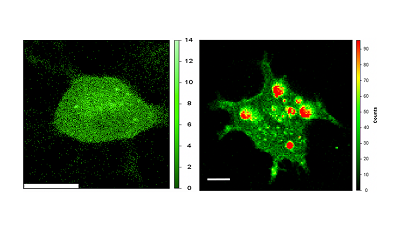Researcher Suzanne Scarlata Identifies a “Good” Stress Response in Cells
Department(s):
Chemistry & Biochemistry 
Newly published research led by Suzanne Scarlata, Richard Whitcomb Professor in the Department of Chemistry and Biochemistry, describes a mechanism in mammalian cells that enables the assembly of stress granule proteins capable of protecting messenger RNA (mRNA) during normal non-stress physiological conditions.
The research was published Oct. 19 by the journal Science Signaling.
Stress granules are small compartments where cells that are under stress—from toxins, starvation, heat or cold shock, osmotic stress that causes shrinking or swelling—sequester important proteins and mRNA. Stress granules help protect mRNAs, which are energetically costly to synthesize, from degradation.
The Scarlata lab studies proteins called G proteins that relay information from molecules outside the cell to inside the cell. The lab specifically focuses on the Gαq family of proteins, which transmit signals from acetylcholine, dopamine, serotonin, histamine, and other chemicals.

“Our study found that activation of Gαq produces a form of ‘normal’ stress granules that have the potential to protect specific mRNAs,” Scarlata said. “This helps to show how hormones and neurotransmitters can direct the synthesis of specific proteins and may help to design more effective pharmaceuticals.”
G proteins control responses that range from light perception to heart rhythm, and they help make sure that signals are directed properly through the brain and spinal cord, and that muscles contract and relax appropriately. Approximately 30 percent of pharmacological agents in the United States target G proteins.
In addition to Scarlata, authors of the paper are fourth-year graduate students Androniqi Qifti and Lela Jackson; Ashima Singla ’17 (MS); and former postdoctoral fellow Osama Garwain, now at Agilent Technologies Inc.